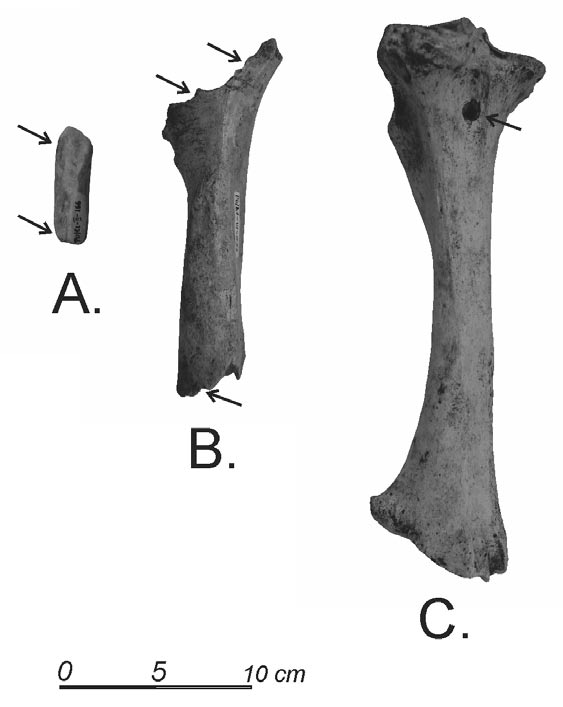Carnivore impact on cave bear bones and the analysis of their dispersion. Case study: UrŞilor cave (NW Romania)
DOI:
https://doi.org/10.3986/ac.v45i3.3329Ključne besede:
Ursus spelaeus, tafonomija, ISD, ugrizi, jama Urşilor, Romunski KarpatiPovzetek
In taphonomy, the study of carnivore modification of fossil bones and the analysis of their dispersion represent the best approach to assessing the extent of bone modification and displacement for a given bone assemblage. Here we analyze the excavated bone deposit from Urşilor Cave, a well-documented and fossil-rich Upper Pleistocene cave bear site from the Romanian Carpathian Mountains. More than 1400 limb bones or bone remains were analyzed (NISPleft and right = 1424) and 69 measurable puncture marks were identified, measured and morphologically analyzed. Moreover, for assessing the degree of bone scattering, almost 540 cave bear limb bones and mandibles were refitted and the Index of Skeletal Disjunction (ISD) was calculated for the entire bone assemblage. More than 30 % of the analyzed cave bear limb bones were affected by carnivores: the ulnae were the most affected (39.3 %) while the humeri and femora were less modified (24.7 % and 25.5 %, respectively). The range of variation in size of the puncture marks, the morphological features of various tooth marks and the faunal composition of the studied bone assemblage indicate that at least two carnivore taxa are responsible for the bone modifications. The results obtained for the ISD index indicate higher displacement for femora when compared to other bones (e.g. tibiae, mandibles, humeri). Our analyses of bone modifications caused by carnivores indicate a low level of the scattering of intensely modified (by in situ consumption) bones, and notable carnivore impact on the configuration of the bone assemblage.
Key words: Ursus spelaeus, taphonomy, ISD, tooth marks, Urşilor Cave, Romanian Carpathians.
Vpliv zveri na kosti jamskih medvedov iz jame UrŞilor (SZ Romunija) in analiza njihove razkropljenosti
Proučevanje sledov zveri na fosilnih kosteh in razkropljenosti kosti v prostoru je najboljše tafonomsko orodje za pridobivanje podatkov o obsegu takšnih pojavov znotraj posameznega paleontološkega zbira. V raziskavi obravnavamo kosti jamskega medveda iz jame Urşilor, dobro raziskanega mlajšepleistocenskega najdišča v Romunskih Karpatih. Analizirali smo več kot 1424 dolgih cevastih kosti okončin ali njihovih odlomkov in pri tem prepoznali, izmerili in morfološko analizirali 69 odtiskov zob. Poleg tega smo izračunali indeks razkropljenosti okostja (Index of Skeletal Disjunction, ISD) za celotni paleontološki zbir, zaradi česar smo sestavili skoraj 540 dolgih cevastih kosti okončin in spodnjih čeljustnic jamskega medveda. Sledove zveri smo prepoznali na več kot 30 % kosti okončin, najpogosteje na komolčnicah (39.3 %), nekoliko redkeje pa na nadlahtnicah in stegnenicah (24.7 % oz. 25.5 %). Variabilnost v velikosti odtiskov zob, njihovih morfoloških značilnostih in favnistični sestavi proučevanega paleontološkega zbira pričajo o tem, da sta ugotovljene spremembe medvedjih kosti povzročili vsaj dve različni zveri. Vrednosti indeksa razkropljenosti okostja kažejo na izrazitejšo razkropljenost stegnenic v primerjavi z drugimi kostmi (npr. golenicami, nadlahtnicami, spodnjimi čeljustnicami). Naša analiza kaže na skromno razkropljenost intenzivno obgrizenih kosti (zaradi hranjenja v sami jami) in znaten vpliv zveri na konfiguracijo paleontološkega zbira.
Ključne besede: Ursus spelaeus, tafonomija, ISD, ugrizi, jama Urşilor, Romunski Karpati.
Prenosi

Prenosi
Objavljeno
Kako citirati
Številka
Rubrike
Licenca
Avtorji jamčijo, da je delo njihova avtorska stvaritev, da v njem niso kršene avtorske pravice tretjih oseb ali kake druge pravice. V primeru zahtevkov tretjih oseb se avtorji zavezujejo, da bodo varovali interese založnika ter da bodo povrnili morebitno škodo.
Podrobneje v rubriki: Prispevki




